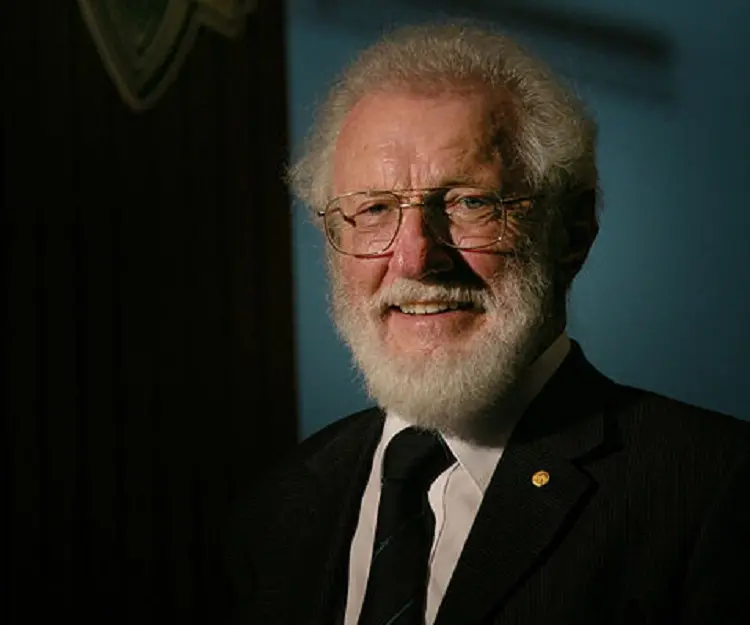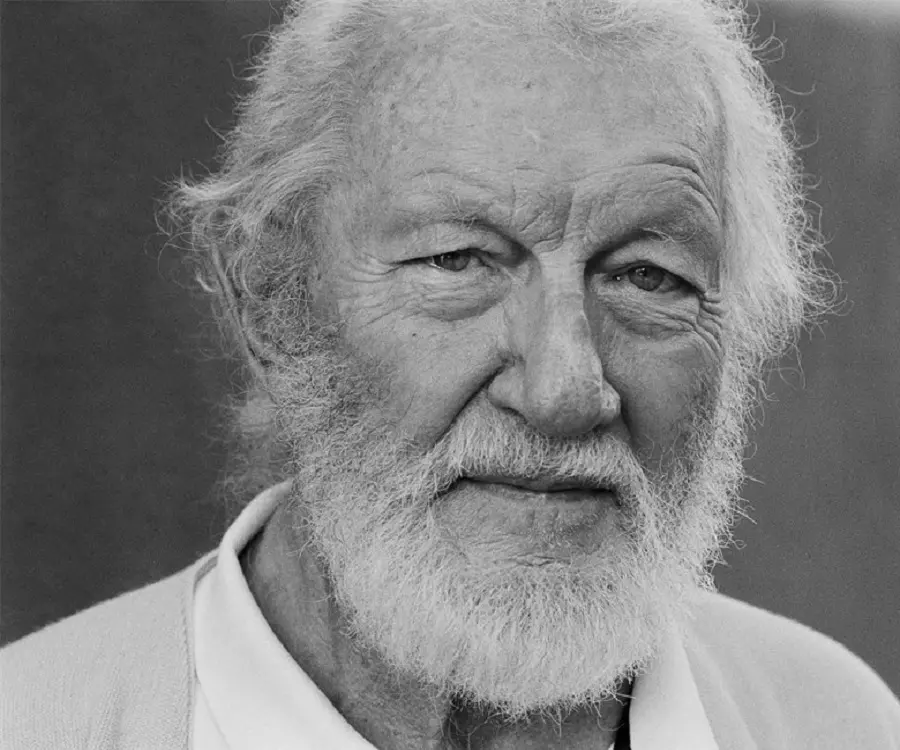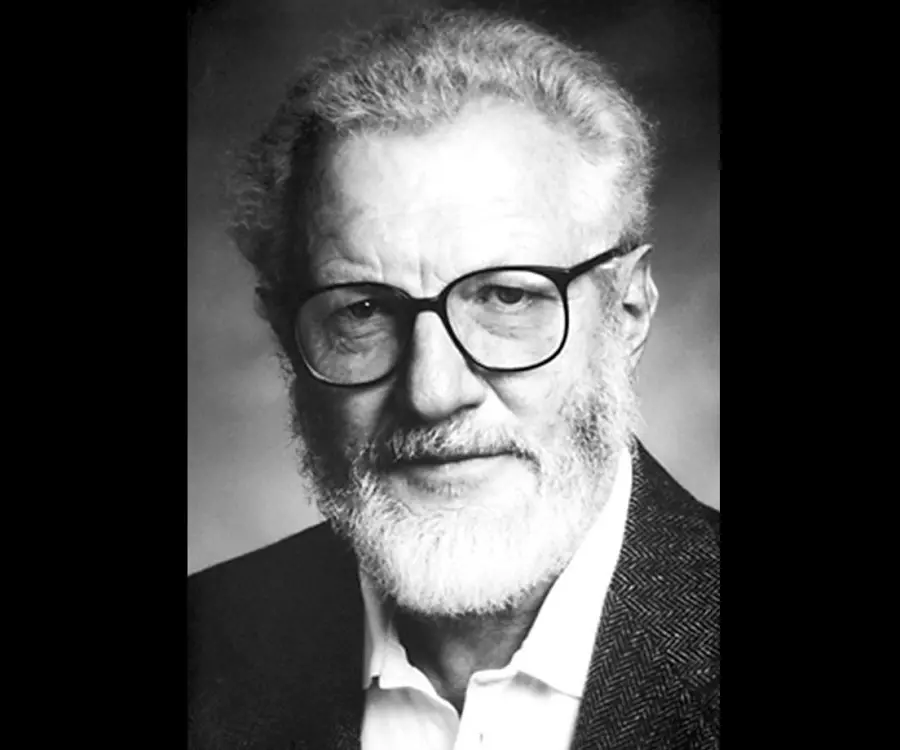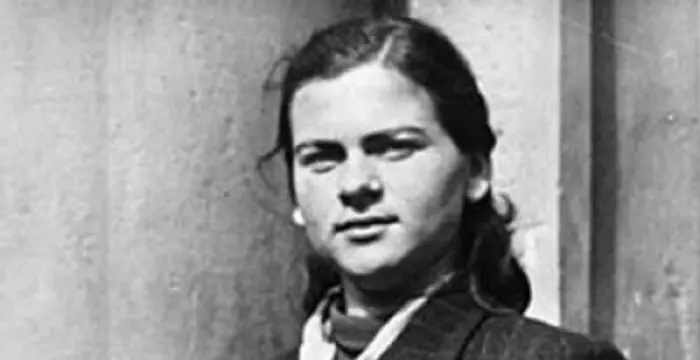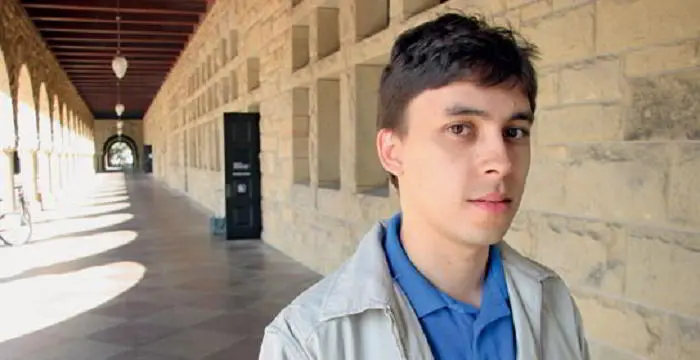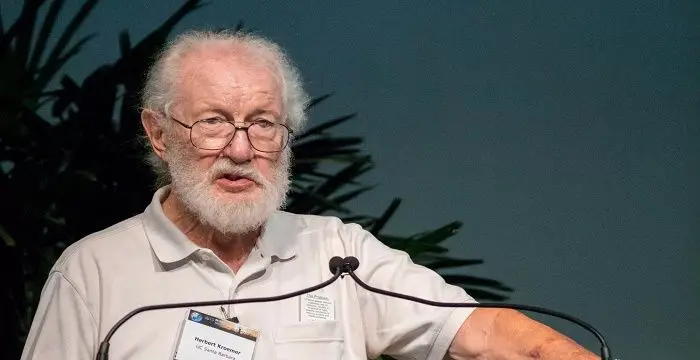
Herbert Kroemer - Scientists, Family and Childhood
Herbert Kroemer's Personal Details
Herbert Kroemer is an eminent German-American physicist who won the Nobel Prize in Physics in 2000
| Information | Detail |
|---|---|
| Birthday | August 25, 1928 |
| Nationality | German |
| Famous | Scientists, Physicists |
| Birth Place | Weimar, Germany |
| Gender | Male |
| Sun Sign | Virgo |
| Born in | Weimar, Germany |
| Famous as | Physicist |
// Famous Physicists
Henry Cavendish
Henry Cavendish was a theoretical chemist and physicist, renowned for discovery of hydrogen and calculation of the mass of earth. To know more about his childhood, profile, timeline and career read on
Walter Kohn
Nobel Laureate Walter Kohn was an Austrian-born American theoretical chemist and physicist. Check out this biography to know about his childhood, life, achievements, works & timeline.
Nikola Tesla
Nikola Tesla was a Serbian-American inventor, best known for his development of alternating current electrical systems. This biography of Nikola Tesla provides detailed information about his childhood, life, achievements, works & timeline.
Herbert Kroemer's photo
Who is Herbert Kroemer?
Herbert Kroemer is an eminent German-American physicist who won the Nobel Prize in Physics in 2000 "for developing semiconductor heterostructures used in high-speed- and opto-electronics". He was brilliant as a child and quite disruptive at school. It was only because of his academic excellence that he evaded expulsion. After graduating from gymnasium he first entered University of Jena with physics. But because of the atmosphere there, he fled to West Germany and managed to get admission at University of Göttingen, from where he earned his PhD at the age of twenty-four. Subsequently, he began his career as a ‘House Theorists’ at the Central Telecommunications Laboratory (FTZ) of the German postal service, bur soon started experimenting on the frequency limitations of the new transistors, which led to his work on heterostructures. Later he worked at different places such as RCA Laboratories in New Jersey, Philips in Hamburg, Varian Associates in California, University of Colorado at Boulder, and University of California, Santa Barbara. At each place he carried on researches on different semiconductor topics. However, it was his work on the heterostructures, which earned him the Nobel Prize in Physics and paved the way for great technological development.
// Famous Scientists
Juliane Koepcke
Juliane Koepcke is a German-Peruvian biologist, who was the lone survivor among the 92 passengers and crew of the ill-fated LANSA Flight 508 that crashed in the Peruvian rainforest on 24 December 1971. Know more about her life in this biography.
Henry Cavendish
Henry Cavendish was a theoretical chemist and physicist, renowned for discovery of hydrogen and calculation of the mass of earth. To know more about his childhood, profile, timeline and career read on
Konstantin Tsiolkovsky
Konstantin Tsiolkovsky was a Russian rocket scientist and a pioneer of astronautics. This biography provides detailed information about his childhood, family, personal life, career, achievements, etc.
Childhood & Early Life
Herbert Kroemer was born on August 25, 1928, in Weimar, which after the Second World War became a part of German Democratic Republic (East Germany). None of his parents attended high school. His father worked for city administration and his mother was a typical German homemaker.
Herbert is the eldest of his parent’s three children. Though little educated, his parents were determined to give their children the best education. His mother was especially keen on it and relentlessly pushed him to score the highest mark in class.
He was a brilliant student, especially fond of physics, chemistry and mathematics. However, just like many other brilliant students, young Herbert frequently felt very bored and entertained himself by disturbing his classmates. It was his academic excellence, which prevented him from being expelled.
In 1947, he passed out from gymnasium and entered the University of Jena with physics. Unfortunately, by the following year, the University came under state scrutiny and students began to disappear; some escaped to West Germany, others were arrested and sent to work in mines.
In 1948, Kroemer moved to Berlin as a summer student at the Siemens Company. As the ‘Berlin airlift’ began he decided to move to West Germany via one of the empty airlift return flights. Before going over, he wrote to several West German universities for admission, but did not receive any reply.
On reaching West Germany, he remembered one of his Jena professors, who had asked him to convey his greetings to Professor König in Göttingen. Therefore, he met König, who told him the admission to physics department was closed.
Nonetheless, he asked him to meet Professor Richard Becker and Dr. Günther Leibfried for a friendly chat. They in turn asked him to meet Wolfgang Paul and Robert Pohl. Soon he realized that the professors were actually trying to evaluate him.
Whatever was the purpose behind these ‘friendly chats’, he ultimately obtained admission at the University of Göttingen and found the environment there “wonderfully stimulating”. However, life was not easy for him.
As his father could no longer support him because of currency difference he had to work in an aluminum factory in night shifts and study during the day. In time, he started working under Fritz Sauter on what later began to be known as band offsets at heterojunctions for his diploma (MS) thesis.
Soon, he became engrossed in heterojunctions. Sometime now, he also gave a talk on John Bardeen and Walter Brattain's paper ‘Physical Principles Involved in Transistor Action’ and made some suggestions about a few points raised by the authors.
Sauter was highly excited about it and asked him to stop working on diploma thesis and submit his paper immediately. Although he objected to this, but did what he was told. Thus in 1951, he received his diploma in theoretical physics.
Sauter now wanted Kroemer to concentrate on his PhD thesis and following his advice Kroemer began working on hot-electron effects, in the collector space-charge layer of the then-new transistor. Eventually he obtained his PhD in 1952.
Career
Soon after receiving his PhD in 1952, Herbert Kroemer began his career as a ‘House Theorists’ at the Central Telecommunications Laboratory (FTZ) of the German postal service. His duty was to answer any theoretical question that any group member might have and give weekly talk on any appropriate subject.
Later, he began working on the frequency limitations of the new transistors, which led to his work on heterostructures. In 1954, he wrote a paper outlining his first ideas about the heterostructure bipolar transistor.
Later in the same year, he shifted to the United States of America and joined the RCA Laboratories in Princeton, New Jersey as research scientist. Here he resumed his work on heterostructures and published two important papers.
In one of them, published in 1957, he spelled out the concept of quasielectric fields, which he considered to be the fundamental design principle for all heterostructures. Unfortunately, it attracted little attraction.
Soon he began to feel homesick and in 1957 went back to Germany. There he joined Philips Semiconductor Research Group in Hamburg as the Group Leader. However, he was not fully satisfied with the work.
Therefore on getting a call from Varian Associates in Palo Alto, California, he returned to America in 1959 and joined the institute as Senior Scientist. It was while working here in 1963 that he proposed the theory that would bring him the Nobel Prize many years later.
This was also the year, when he concluded that it was possible to achieve a steady-state population inversion in semiconductor diode laser even at room temperature if the outer regions are provided with a wider energy gap.
Unfortunately, the paper was ignored. He was also refused funds for carrying on further experimentation. Therefore for next ten years, he worked on Gun effect, which concerns the high-frequency oscillation of electrical current flowing through certain semiconducting solids.
In 1966, he left Varian Associate and joined Semiconductor Research and Development Laboratory as Head of the New Phenomena Section. Two years later, he made another move and joined the University of Colorado at Boulder as Professor of Electrical Engineering in 1968.
It was at Colorado University that he returned to heterostructure. The early 1970s was spent in working on the theory of band offsets, which refers to the relative alignment of the energy bands at a semiconductor heterojunction.
In 1976, he moved to University of California, Santa Barbara, where he remained until his retirement in 2012. Here he continued his work on band offsets and developed an experimental method to determine these energy bands.
In the late 1970s, he returned to heterostructure bipolar transistor (HBT), a work he had started in early 1950s. He soon realized that the technology developments, which enabled the invention of the DH laser, was also appropriate for development of the HBT and began to advocate that strongly.
Professor Kroemer retired in 2012. However, he remains attached to the University of California as Professor Emeritus and continues to work on various semiconductor topics.
Major Works
Herbert Kroemer is best known for his work on heterostructure bipolar transistors (HBP). In 1957, he published a paper, in which he described his idea of quasielectric fields, which turned out to be the fundamental design for all heterostructures.
Later in 1963, he carried out the calculation and theoretically showed that heterostructure transistor would be superior to a conventional transistor, especially for certain high-frequency uses. This is because unlike most computer chips and semiconductor components heterostructures are made of different materials.
Awards & Achievements
In 2000, Herbert Kroemer was jointly awarded the Nobel Prize in Physics "for developing semiconductor heterostructures used in high-speed- and opto-electronics". His co-recipients were Zhores I. Alferov and Jack S. Kilby. Kroemer and Alferov got one-fourth of prize share each, while Kilby got the other half "for his part in the invention of the integrated circuit".
In addition, he has received numerous other awards, among which J J Ebers Award (1973) and IEEE Medal of Honor (2002) are most significant.
He was elected a member of National Academy of Engineering (Foreign Associate) in 1997 and National Academy of Sciences (Foreign Associate) in 2003.
Personal Life & Legacy
Professor Kroemer is married to Marie Louise Kroemer, whom he met as a student at the University of Göttingen. The couple has five children.
Asteroid 24751, discovered on 21 September 1992 has been named as Asteroid Kroemer in his honor.
Trivia
When Kroemer decided to pursue higher studies with physics, his father, not knowing anything about the subject, merely asked him if he could make a decent living with it. When Kroemer assured him that he could always become a teacher at a gymnasium, he was contented.
Although he was appointed as the Professor of Electrical Engineering at the University of Colorado and later at the University of California his degree in Engineering is honorary.
// Famous Virgo Celebrities peoples
Temple Grandin
Temple Grandin is a well-known American writer, autistic activist and animal expert. This biography profiles her childhood, life, achievements, career and timeline
Alex Holtti
Check out all that you wanted to know about Alex Holtti, the famous Danish Viner & YouTuber; his birthday, his family and personal life, his girlfriends, fun trivia facts and more.
Benjamin Atkinson
Benjamin Atkinson is the son of the world-renowned British actor and comedian, Rowan Atkinson. Check out this biography to know about his childhood, family, personal life, including his age, birthday, etc.
Herbert Kroemer's awards
| Year | Name | Award |
|---|---|---|
Other | ||
| 0 | 2000 - Nobel Prize in Physics | |
| 0 | 2002 - IEEE Medal of Honor | |
| 0 | 1973 - J J Ebers Award | |
Herbert Kroemer biography timelines
- // 25th Aug 1928Herbert Kroemer was born on August 25, 1928, in Weimar, which after the Second World War became a part of German Democratic Republic (East Germany). None of his parents attended high school. His father worked for city administration and his mother was a typical German homemaker.
- // 1947In 1947, he passed out from gymnasium and entered the University of Jena with physics. Unfortunately, by the following year, the University came under state scrutiny and students began to disappear; some escaped to West Germany, others were arrested and sent to work in mines.
- // 1948In 1948, Kroemer moved to Berlin as a summer student at the Siemens Company. As the ‘Berlin airlift’ began he decided to move to West Germany via one of the empty airlift return flights. Before going over, he wrote to several West German universities for admission, but did not receive any reply.
- // 1951Sauter was highly excited about it and asked him to stop working on diploma thesis and submit his paper immediately. Although he objected to this, but did what he was told. Thus in 1951, he received his diploma in theoretical physics.
- // 1952Sauter now wanted Kroemer to concentrate on his PhD thesis and following his advice Kroemer began working on hot-electron effects, in the collector space-charge layer of the then-new transistor. Eventually he obtained his PhD in 1952.
- // 1952Soon after receiving his PhD in 1952, Herbert Kroemer began his career as a ‘House Theorists’ at the Central Telecommunications Laboratory (FTZ) of the German postal service. His duty was to answer any theoretical question that any group member might have and give weekly talk on any appropriate subject.
- // 1954Later, he began working on the frequency limitations of the new transistors, which led to his work on heterostructures. In 1954, he wrote a paper outlining his first ideas about the heterostructure bipolar transistor.
- // 1957In one of them, published in 1957, he spelled out the concept of quasielectric fields, which he considered to be the fundamental design principle for all heterostructures. Unfortunately, it attracted little attraction.
- // 1957Soon he began to feel homesick and in 1957 went back to Germany. There he joined Philips Semiconductor Research Group in Hamburg as the Group Leader. However, he was not fully satisfied with the work.
- // 1957Herbert Kroemer is best known for his work on heterostructure bipolar transistors (HBP). In 1957, he published a paper, in which he described his idea of quasielectric fields, which turned out to be the fundamental design for all heterostructures.
- // 1959 To 1963Therefore on getting a call from Varian Associates in Palo Alto, California, he returned to America in 1959 and joined the institute as Senior Scientist. It was while working here in 1963 that he proposed the theory that would bring him the Nobel Prize many years later.
- // 1963Later in 1963, he carried out the calculation and theoretically showed that heterostructure transistor would be superior to a conventional transistor, especially for certain high-frequency uses. This is because unlike most computer chips and semiconductor components heterostructures are made of different materials.
- // 1966 To 1968In 1966, he left Varian Associate and joined Semiconductor Research and Development Laboratory as Head of the New Phenomena Section. Two years later, he made another move and joined the University of Colorado at Boulder as Professor of Electrical Engineering in 1968.
- // 1973 To 2002In addition, he has received numerous other awards, among which J J Ebers Award (1973) and IEEE Medal of Honor (2002) are most significant.
- // 1976 To 2012In 1976, he moved to University of California, Santa Barbara, where he remained until his retirement in 2012. Here he continued his work on band offsets and developed an experimental method to determine these energy bands.
- // 21st Sep 1992Asteroid 24751, discovered on 21 September 1992 has been named as Asteroid Kroemer in his honor.
- // 1997 To 2003He was elected a member of National Academy of Engineering (Foreign Associate) in 1997 and National Academy of Sciences (Foreign Associate) in 2003.
- // 2000In 2000, Herbert Kroemer was jointly awarded the Nobel Prize in Physics "for developing semiconductor heterostructures used in high-speed- and opto-electronics". His co-recipients were Zhores I. Alferov and Jack S. Kilby. Kroemer and Alferov got one-fourth of prize share each, while Kilby got the other half "for his part in the invention of the integrated circuit".
- // 2012Professor Kroemer retired in 2012. However, he remains attached to the University of California as Professor Emeritus and continues to work on various semiconductor topics.
// Famous German peoples
Jordan Carver
Jordan Carver is a famous German model. Let’s take a close look at her personal life, including her age, career, net worth, achievements and some fun facts.
Jürgen Klopp
Jürgen Klopp is a German football manager, and a former professional football player. Check out this biography to know more about his childhood, family, personal life, etc.
Irma Grese
Irma Grese was a notorious German Nazi concentration camp guard during the Second World War. This biography profiles her childhood, life, horrifying acts, death and other facts.
Juliane Koepcke
Juliane Koepcke is a German-Peruvian biologist, who was the lone survivor among the 92 passengers and crew of the ill-fated LANSA Flight 508 that crashed in the Peruvian rainforest on 24 December 1971. Know more about her life in this biography.
Jawed Karim
Jawed Karim is a German-American internet entrepreneur, technologist and co-founder of the video-sharing website, YouTube. Check out this biography to know about his childhood, family, personal life, achievements, age, etc.
Charles Bukowski
Charles Bukowski was a German-born American novelist, short story writer and poet. With this biography, learn in details about his childhood, life, works, career and timeline
Herbert Kroemer's FAQ
What is Herbert Kroemer birthday?
Herbert Kroemer was born at 1928-08-25
Where is Herbert Kroemer's birth place?
Herbert Kroemer was born in Weimar, Germany
What is Herbert Kroemer nationalities?
Herbert Kroemer's nationalities is German
What is Herbert Kroemer's sun sign?
Herbert Kroemer is Virgo
How famous is Herbert Kroemer?
Herbert Kroemer is famouse as Physicist



